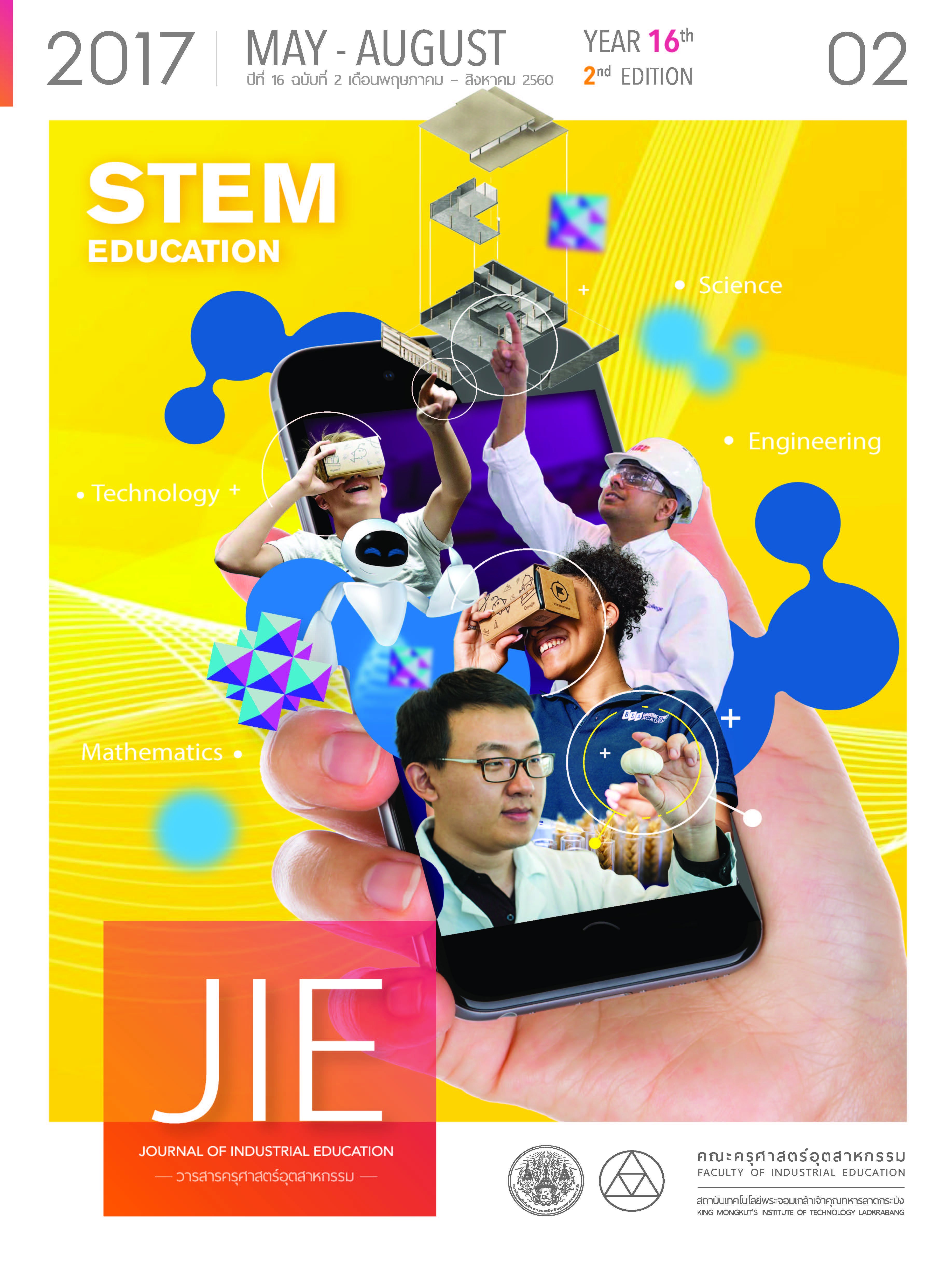THE DEVELOPMENT OF AN INTERACTIVE LEARNING CLASSROOM BASED ON INTERACTIVE LEARNING AND DISCOVERY LEARNING USING SOCIAL MEDIA TECHNOLOGY TO ENHANCE STUDENT INTERACTION, ACHIEVEMENT AND SATISFACTION
Main Article Content
Abstract
The purposes of this research were to 1) develop an interactive learning classroom based on interactive learning and discovery learning using social media technology 2) examine student interaction and achievement after using an interactive learning classroom 3) study student satisfaction towards an interactive learning classroom. The purposive sample group was 20 undergraduate students enrolled in a human resource management course during the first semester of the 2016 academic year. The research instruments were 1) a learning needs questionnaire 2) an interactive learning book 3) a questionnaire collecting experts’ opinions towards appropriateness of an interactive learning book 4) an observation checklist of student interaction based on discovery learning 5) a questionnaire of student interaction based on interactive learning and discovery learning 6) a pre-test and a post-test 7) a student satisfaction questionnaire. Data were analyzed by using content analysis, mean, standard deviation and t-test.
The research results were summarized as following:
1) An interactive learning classroom based on interactive learning and discovery learning consisted of an interactive learning book covering human resource management content and the selected web-based application with social media technology. It was also integrated with students’ learning needs in using simulations, role playing, real cases, problem solving activities, practice and discussion in instruction. Its effectiveness was verified by experts as appropriate (= 4.92, S.D. = 0.13) at a very high level in its content, structure and presentation.
2) For student interaction, the mean of discovery learning observed by a teacher was very high in interaction level at 4.93. The mean of interactive learning and discovery learning evaluated by students was high in interaction level at 4.20. For student achievement, scores before and after applying an interactive learning classroom was 54.50 and 87.80 of 100, respectively. The posttest scores were significantly higher than the pretest scores at 0.05 level of significance.
3) Student satisfaction towards an interactive learning classroom was at a high level (= 4.44, S.D. = 0.58). Students found it as a new, fun, interesting, motivating and good way to learn with ability to share and see answers with different perspectives and it is a good practice of learning by discovering answers including easiness to participate and interact with the classroom.
In conclusion, an interactive learning classroom based on interactive learning and discovery learning using social media technology can be used to promote student interaction, achievement and satisfaction with positive results and its development for instructional use will be more effective if these factors, that is, time management, technology and teaching competencies are taken into consideration.
Article Details
"The opinions and contents including the words in papers are responsibility by the authors."
"ข้อคิดเห็น เนื้อหา รวมทั้งการใช้ภาษาในบทความถือเป็นความรับผิดชอบของผู้เขียน"
References
[2] Voller, S., Blass, E., & Culpin, V. 2011. The Future of Learning: Insights and Innovations from Executive Development. New York: Palgrave Macmillan.
[3] Saxena, S 2013. How important is use of technology in education. Retrieved May 6, 2016, from http://www.edtechreview.in/news/681-technology-in-education.
[4] Ferdig, R.E. 2007. Editorial: Examining social software in teacher education. Journal of Technology and Teacher Education, 15 (1), p. 5-10.
[5] Davis, C., Deil-Amen, R., Rios-Aguilar, C. & Gonzalez Canche, M.S. 2012. Social Media in Higher Education: A Literature Review and Research Directions. Retrieved June 25, 2016, from http://www.academia.edu/1220569/Social_Media_in_Higher_Education_A_Literature_Review_and_Research_Directions
[6] Al-Tarawneh, H.A.. 2004. The Influence of Social Networks on Students’ Performance. Journal of Emerging Trends in Computing and Information Sciences, 5 (3), p. 200-205.
[7] Wikipedia. 2016. Interactive Learning. Retrieved April 5, 2016, from https://en.wikipedia.org/wiki/Interactive_Learning
[8] Agrawal, V. 2016. The New Age of Interactive Learning through Social Media. Retrieved April 25, 2016, from https://elearningindustry.com/new-age-interactive-learning-social-media
[9] Paliszkiewicz, J., Koohang, A. 2016. Social Media and Trust: A Multinational study of University Students. Santa Rosa, California: Informing Science Press.
[10] Poore, M. 2013. Using Social Media in the Classroom: A Best Practice Guide. London: SAGE Publications.
[11] Bidgoli, H. 2010. The Handbook of Technology Management: Supply Chain Management, Marketing and Advertising, and Global Management Volume 2. Canada: John Wiley & Son, Inc.
[12] Lam, J. 2015. Collaborative Learning Using Social Media Tools in a Blended Learning Course. In International Conference on Hybrid Learning and Continuing Education. ICHL 2015: Hybrid Learning: Innovation in Education Practices, p.187-198.
[13] Wikipedia. 2016. Social Media. Retrieved May 25, 2016, from http:// https://en.wikipedia.org/wiki/Social_media
[14] Ouf, S., Nasr, M. & Helmy, Y. 2010. An enhanced e-learning ecosystem based on an integration between cloud computing and web 2.0. In IEEE International Symposium on Signal Processing and Information Technology (ISSPIT). Helwan, Egypt. Retrieved April 25, 2016, from http://www.ieeexplore.ieee.org/stamp/stamp.jsp?tp=&arnumber=5711721
[15] Schank, R.C., & Cleary, C. 1995. Engines for Learning. Hillsdale, NJ: Lawrence Erlbaum Associates.
[16] Bruner, J.S. 1966. Some Elements of Discovery. In L.S. Shulman, E.R. Keislar (Ed.), Learning by Discovery: A Critical Appraisal (pp. 104-111). Chicago: Rand McNally.
[17] Rezak, C.J. 2009. Improving Corporate Training Results with Discovery Learning Methodology. Retrieved April 25, 2016 from http://www.paradigmlearning.com/.../WP_Discovery_Learning.pdf.
[18] Patchara Vanichvasin. 2016. The Development of an Interactive Learning Book based on Interactive Learning and Discovery Learning to Enhance Student Interaction and Achievement. Instructional Handouts in Human Resources Management Subject for Business and Computer Education. Bangkok: Kasetsart University.
[19] Vatcharaphong Yosai, Attaporn Ridhikerd & Chantana Viriyavejakul. 2013. Effects of Achievement and Retention on Web-Based Instruction on Workshop Practicum. Journal of Industrial Education, 12 (3), p. 168-173.
[20] Hopkins, B. 2016. Advantages of Using Social Media for Students in Education. Retrieved April 30, 2016, from https://www.academiaapps.com/advantages-social-media-education/

